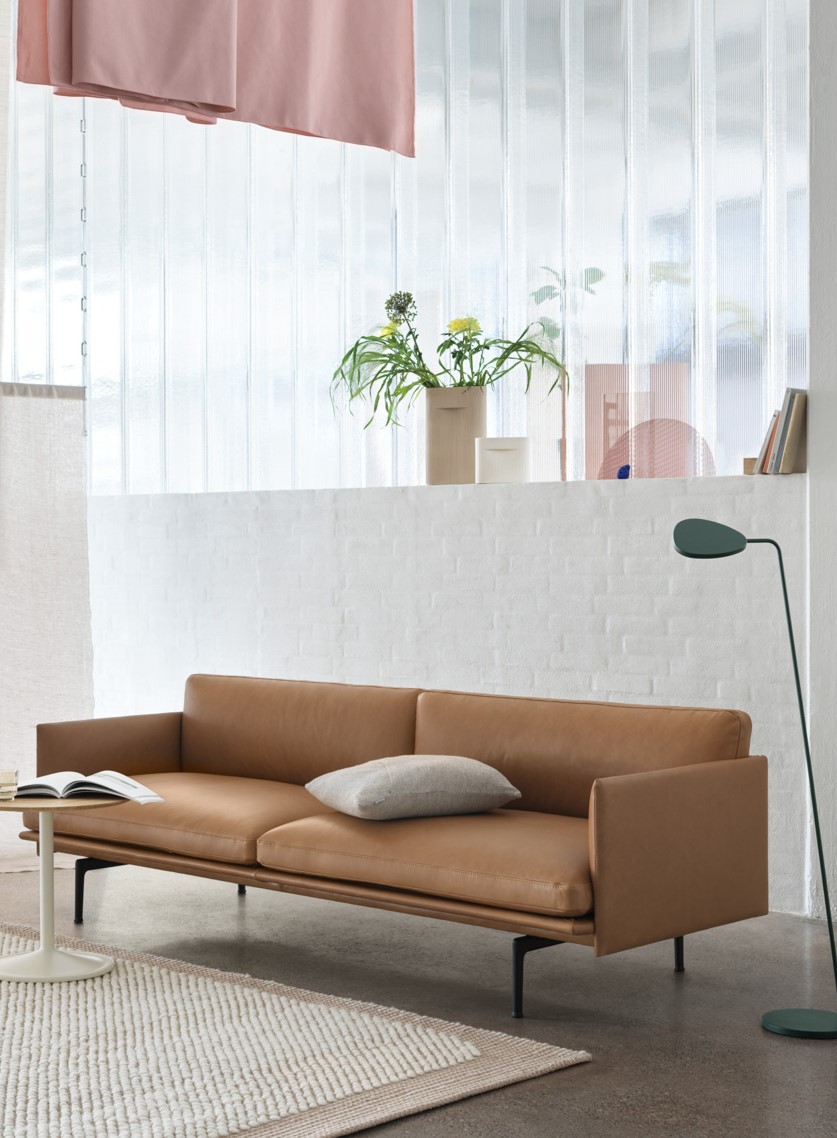
Tips & Tricks to Take Care of Your Leather Sofa
Proper care and protection are essential to maintain its luxurious look and feel.
Leather, while durable, requires specific maintenance to preserve its quality and extend its lifespan. Several factors can compromise the beauty of your leather furniture, from accidental spills to the wear and tear of daily use.
Whether you’re dealing with natural ways to clean, preventing sun damage, or seeking the best products for leather sofa care, understanding the right methods is key. In this guide, we’ll explore effective strategies for leather cleaning, conditioning, and overall maintenance to ensure your sofa remains pristine.
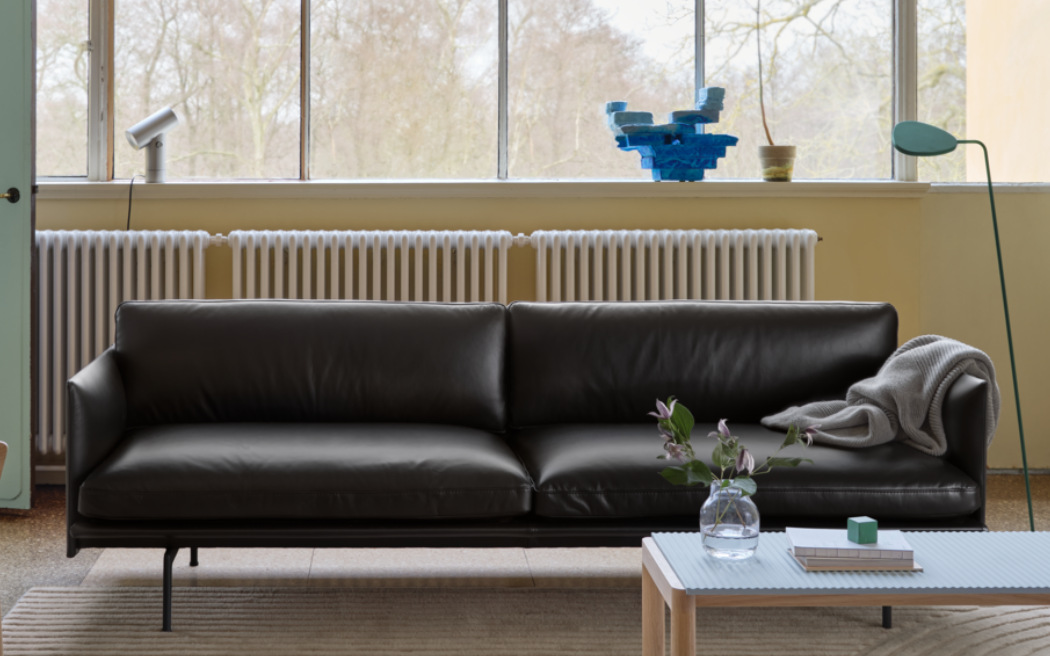
Leather: The Foundation of Your Sofa’s Longevity
Leather sofas, with their rich texture and elegant appearance, are a significant investment for any homeowner. However, not all leather is created equal. The type of leather your sofa is made from, be it full-grain, top-grain, or bonded leather, significantly influences its feel, durability, and how it ages over time.
Full-grain leather, prized for its strength and ability to develop a patina, is considered the highest quality. Top-grain leather offers a balance between quality and cost, providing durability with a more uniform appearance. Bonded leather, made from leftover scraps fused, is more affordable but less durable than its counterparts.
Leather’s natural characteristics, such as pores and grain, make it uniquely sensitive to its environment. This natural material can breathe, absorb moisture, and react to variations in temperature, making it susceptible to drying out, fading, or cracking if not properly cared for. Understanding the specific type of leather and its characteristics is crucial for applying the right protection methods. This knowledge ensures that your investment remains as beautiful and comfortable as the day you bought it, adapting to your home’s environment and lifestyle.
Proper leather sofa care, tailored to the specific type of leather of your sofa, is not just about maintaining its appearance; it’s about preserving the natural qualities that make your leather 2-seater sofa a centrepiece of comfort and style in your home.
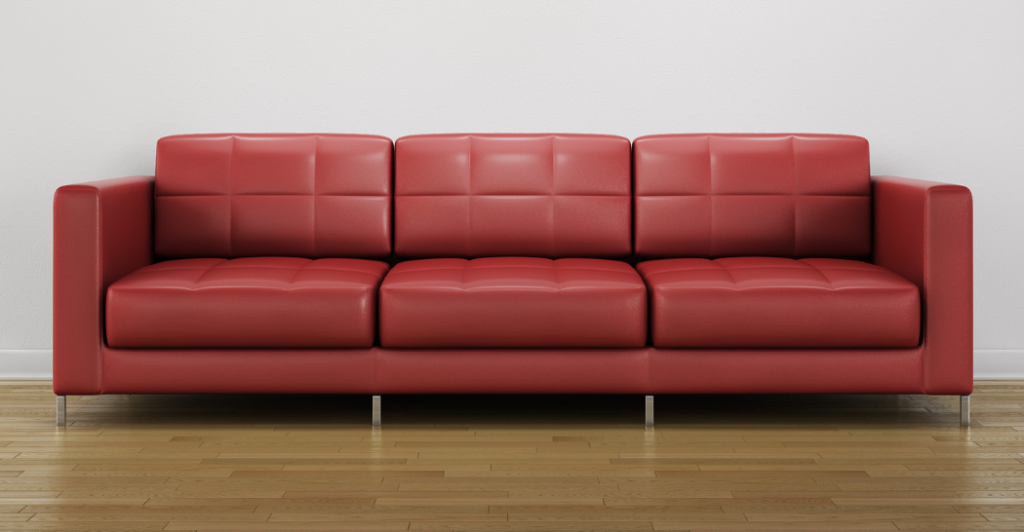
Regular Cleaning and Conditioning: Leather Sofa Care
Maintaining the luxurious look and feel of your leather modular sofa requires a commitment to regular cleaning and conditioning. Here’s why these steps are crucial and how to perform them effectively:
Cleaning your Leather Couch
Frequency: To prevent the accumulation of dirt and oils that can degrade leather over time, it’s recommended to clean your leather corner sofa every three to six months. However, if your sofa sees high traffic or is exposed to spills, a more frequent cleaning schedule may be necessary.
Choosing Cleaning Products: Selecting the right sofa cleaning products is vital. Always opt for cleaners specifically designed for leather. These products are formulated to clean effectively without damaging the leather’s natural oils. Avoid harsh chemicals or household cleaners, as they can cause discolouration or drying.
Step-by-Step Cleaning Guide:
| Dust and Vacuum | Begin by gently dusting your sofa with a soft cloth or using a vacuum with a brush attachment to remove loose dirt and debris. |
| Test the Cleaner | Before applying any cleaner, test it on a small, inconspicuous sofa area to ensure it doesn’t cause discolouration. |
| Apply Cleaner | Using a soft, lint-free cloth, apply the leather cleaner to the sofa in a circular motion, focusing on one section at a time. |
| Wipe and Dry | After cleaning, wipe off any excess cleaner with a clean cloth and allow the sofa to dry naturally. Avoid direct sunlight or heat sources, as they can cause the leather to dry out. |
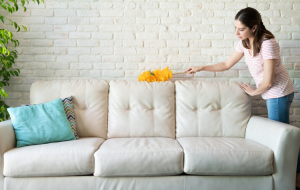
Conditioning your Leather Couch
Importance of Conditioning: Conditioning your leather couch and sofa is as crucial as cleaning. Leather conditioner helps to replenish the natural oils lost over time, preventing the leather from drying out and cracking. Think of it as moisturising your skin to keep it soft and supple.
Recommended Conditioners: Use a high-quality leather conditioner recommended by your sofa’s manufacturer or one that’s suited for your specific type of leather. These conditioners are designed to penetrate the leather, restoring its natural moisture balance without leaving a greasy residue.
Step-by-Step Conditioning Guide:
| Apply Conditioner | After cleaning and ensuring the sofa is completely dry, apply a small amount of conditioner to a soft cloth. |
| Gentle Application | Gently rub the conditioner into the leather in circular motions, covering the entire surface. |
| Allow to Absorb | Let the conditioner absorb into the leather for at least 30 minutes or as directed by the product instructions. |
| Buff | Finally, buff the sofa with another clean, soft cloth to bring out the shine and ensure an even finish. |
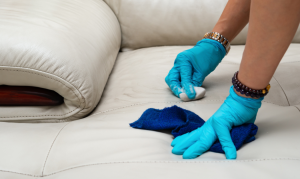
Protecting Leather Sofa and Couch from Sunlight
Leather sofas add a touch of elegance and comfort to any living space. However, without proper care, the luxurious appearance of leather can deteriorate over time, especially when exposed to sunlight and heat. Understanding how these elements affect leather and taking steps to protect your sofa is essential for maintaining its beauty and longevity.
How Sunlight and Heat Affect Leather
Sunlight: Prolonged exposure to direct sunlight can cause the colour of your leather couch to fade. Leather, being a natural material, contains oils that can dry out when exposed to the sun, leading to cracking and weakening of the material.
Heat: Similar to sunlight, excessive heat from radiators, fireplaces, or air conditioning vents can dry out leather. This not only accelerates the fading process but can also cause the leather to become brittle and crack, significantly reducing the lifespan of your sofa.
Tips for Protecting Leather Sofas
| TIP | DESCRIPTION |
|---|---|
| Positioning Away from Direct Sunlight | When arranging your living space, try to position your leather sofa away from windows where it would receive direct sunlight. If your room layout makes this challenging, consider using blinds or drapes during the sunniest parts of the day to protect your sofa. |
| Avoiding Heat Sources | Ensure your leather sofa is situated at a safe distance from heat sources. This includes radiators, heaters, and air vents. A good rule of thumb is to maintain at least two feet of distance between your sofa and any heat source to prevent overheating and drying of the leather. |
| Using Window Treatments | Investing in quality window treatments can significantly reduce the amount of sunlight that enters your room. Options such as UV-filtering window films, blinds, curtains, or shades not only protect your leather sofa but can also enhance the aesthetic appeal of your space. These treatments allow you to control the amount of light and heat that enters the room, offering an additional layer of protection for your leather furniture. |
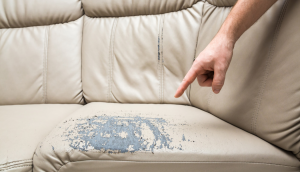
Minimising Wear and Tear on Your Leather Sofa
A leather sofa is a significant investment that adds a touch of sophistication to your home. To ensure its longevity and keep it looking its best, it’s crucial to minimise unnecessary wear and tear. Here’s how to protect your leather sofa from scratches, scuffs, and damage that could compromise its beauty and structure.
| TYPE | TIP 1 | TIP 2 |
|---|---|---|
| Preventing Scratches and Scuffs | One of the simplest yet most effective ways to protect your leather sofa is by being cautious with sharp objects. Avoid using or placing items with sharp edges near the sofa. This includes items like belts, shoe buckles, pet claws, or any metal accessories that could potentially scratch the surface. | Incorporating throws or blankets adds an extra layer of style and comfort to your living space and serves as a protective barrier for your leather sofa. They can catch and cushion any accidental drops or scrapes, preventing direct damage to the leather surface. |
| Maintaining Shape and Structure | Leather sofas are designed to provide optimum support and comfort. However, consistently overloading the sofa or sitting on the arms can cause the leather to stretch and the sofa’s structure to warp over time. Encourage guests and household members to use the sofa gently and avoid placing heavy objects on it that could deform its shape. | If your leather sofa comes with removable cushions, make it a habit to rotate them regularly. This practice distributes wear evenly, helping to maintain the shape and comfort of the sofa over time. It also prevents the development of indentations and sagging in frequently used spots. |
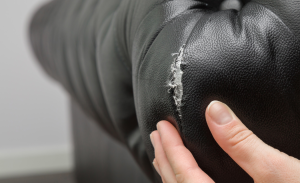
Quick Actions to Tackle Spills on Your Leather Sofa
When spills happen, swift action is key to preventing permanent stains on your leather couch and sofa. Here’s how to manage spills effectively and the cleaning products you should avoid to protect your leather couch and sofa.
| TYPE | TIP 1 | TIP 2 |
|---|---|---|
| Handling Spills Promptly | As soon as a spill occurs, grab a clean, dry cloth and gently blot the area. Avoid rubbing, as this can push the liquid deeper into the leather, making the stain harder to remove. Blotting helps lift the spill from the surface without spreading it further. | For spills that need a bit more attention, dampen a cloth with distilled water and gently dab the area. Tap water can contain minerals that might harm the leather, so distilled water is a safer choice. |
| Choosing the Right Cleaning Products | Steer clear of cleaning products that contain harsh chemicals, such as ammonia or bleach. These can damage the leather’s finish, causing it to dry out and crack over time. | When cleaning spills, use only white or neutral-coloured cloths. Coloured materials can transfer dye onto the leather, especially when damp, leading to discolouration. |

Keeping Your Leather Sofa Safe from Pets and Children
Leather sofas add elegance to any room, but pets and children can pose a challenge to their upkeep. Here are practical tips to harmonise your stylish piece with the dynamism of family life and furry friends.
| TYPE | TIP 1 | TIP 2 |
|---|---|---|
| Embrace Protective Measures | Invest in high-quality sofa covers or throws. These not only protect your leather from scratches and spills but also offer an easy-to-clean solution. Choose covers that complement your decor to maintain aesthetic appeal. | Consider using pet barriers or gates to limit access to the living room when you’re not there to supervise. This simple step helps prevent unsupervised interactions that might lead to damage. |
| Educate and Train | Teach children that the sofa is not a playground. Encourage them to use it gently and respect its value. Simple rules about no jumping or sharp toys can go a long way. | Consistent training can teach pets that the sofa is off-limits. Use positive reinforcement techniques to guide them to their own beds or designated resting areas instead. |
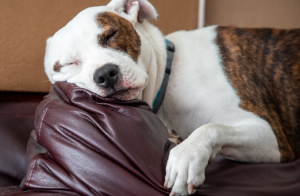
Leather Sofa Care & Maintenance Through the Year
Adjusting your leather couch care with the seasons ensures it stays in pristine condition year-round. Here’s how to adapt your maintenance routine to the changing weather.
| SEASON | TIP 1 | TIP 2 |
|---|---|---|
| WINTER | Winter’s dry air can dehydrate leather, leading to cracks. Using a humidifier in your home helps maintain optimal humidity levels, preserving your sofa’s suppleness. | The lack of moisture in the air means your leather might need more nourishment. Apply a quality leather conditioner midway through the season to prevent drying and cracking. |
| SUMMER | As the days grow longer, the risk of sun damage increases. Keep your leather sofa out of direct sunlight to prevent fading and drying. Use blinds or curtains to shield it during peak sun hours. | High heat can warp and damage leather. Try to keep your home cool, by using fans or air conditioning to protect the sofa. |
| SPRING & AUTUMN | Use the fresh start of spring to give your leather sofa a thorough clean. This removes any grime accumulated over winter, setting the stage for a clean summer ahead. | Before the harsh winter conditions arrive, inspect your sofa for any issues. Addressing minor scratches or dry spots in autumn can prevent bigger problems later. |
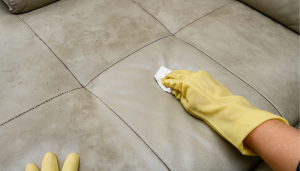
Avoid Common Mistakes: Ensuring Longevity of Your Sofa
Proper leather sofa care is crucial for maintaining the beauty and durability of your sofa. Avoid these common mistakes to keep your leather in top condition.
| MISTAKE TYPE | MISTAKE DESCRIPTION | FIX |
|---|---|---|
| USING HARSH CLEANERS | Turning to generic or harsh cleaning solutions can cause irreparable damage to leather surfaces. | Always opt for cleaners specifically designed for leather. Test any product on a small, inconspicuous area before full application. |
| NEGLECTING REGULAR MAINTENANCE | Letting dust and dirt accumulate can lead to premature wear and tear. | Dust your leather modular sofa weekly with a soft cloth and treat it with a leather conditioner every 6-12 months to maintain its moisture and prevent cracks. |
| IGNORING SPILLS | Delaying the cleanup of spills leads to stains that are difficult, if not impossible, to remove. | Blot spills immediately with a clean, dry cloth. Avoid rubbing, as this can spread the stain. |
| PLACING TOO CLOSE TO HEAT SOURCES | Positioning your leather couch and sofa near heat sources like radiators or sunny windows can cause drying and fading. | Keep your sofa away from direct heat and sunlight. Use drapes or blinds to protect it from sun exposure. |
| OVERLOADING THE SOFA | Excessive weight on the sofa can distort its shape and damage the leather. | Avoid sitting on the armrests or back of the sofa and discourage jumping on it to preserve its structure. |
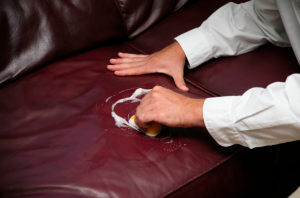
Professional Leather Sofa Care: Choose Expert Maintenance
For your leather couch, professional maintenance can be a game-changer. Let’s explore when to seek expert services and how to select a reputable provider.
- When to Consider: Even with diligent care, your leather couch may need professional attention. If you notice stubborn stains, deep scratches, or signs of ageing like cracking and dryness, it’s time to call in the pros. Additionally, an annual professional clean can rejuvenate your sofa, keeping it in top condition.
- Benefits of Professional Care: Experts in leather maintenance have the tools and knowledge to tackle issues without further damage. They can deep clean, repair, and condition your sofa, extending its life and enhancing its appearance.
Choosing a Reputable Provider for Leather Sofa Care
- Research and Reviews: Start with a thorough online search. Look for companies with excellent reviews and testimonials from satisfied customers. Personal recommendations from friends or family can also guide you to reliable services.
- Check Credentials: A reputable leather maintenance provider should have specific experience and training in leather care. Don’t hesitate to ask about their qualifications and the products they use.
- Ask for Before and After Photos: Seeing the results of their work can give you confidence in their ability to care for your sofa. A trustworthy provider will be proud to showcase their success stories.
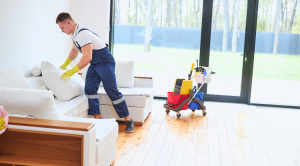
Embracing the Art of Leather Couch and Sofa Care
In wrapping up, the key to a long-lasting and beautiful leather corner sofa lies in regular, mindful maintenance. By understanding the unique needs of leather and adopting a consistent care routine, you can protect your investment and enjoy its comfort and elegance for many years. It’s not just about cleaning and conditioning; it’s about integrating these practices into your lifestyle to ensure your sofa remains as inviting and luxurious as the day you brought it home.
We’d love to hear from you! Share your tips and tricks for maintaining a leather couch and sofa in the comments below. Don’t stop here, our blog is a treasure trove of home care tips and design inspiration. Explore more articles to find innovative ways to enhance and preserve the beauty of your home. Whether you’re a seasoned pro or a first-time leather modular sofa owner, there’s always something new to discover.
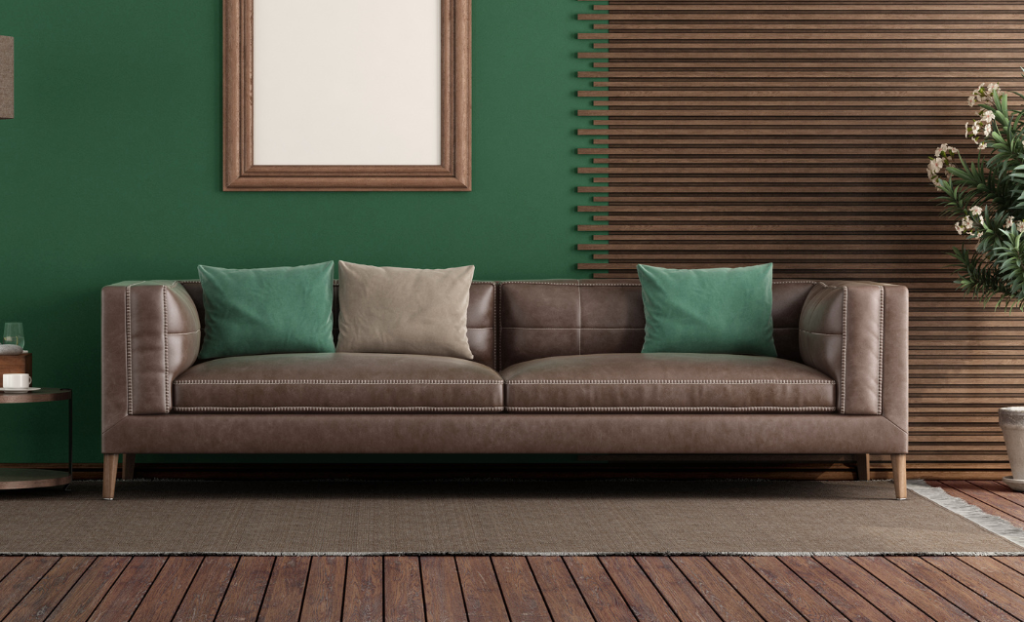
Frequently Asked Questions
Vaseline can moisturize leather in the short term but is not recommended for long-term care as it can attract dirt and lead to deterioration.
While diluted vinegar can be used for cleaning, it should be used cautiously as its acidity can potentially harm leather over time.
Yes, alcohol wipes can remove the protective layer on leather, leading to dryness and potential damage.
Leather sofas should be regularly cleaned and conditioned to preserve their appearance and durability. Avoid direct sunlight and sharp objects to prevent fading and scratches.
Rejuvenate a leather couch by cleaning it with a gentle leather cleaner and applying a leather conditioner to restore moisture and flexibility.
